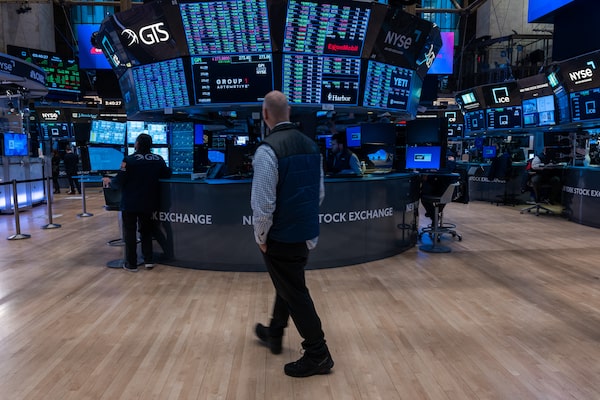
Traders work on the floor of the New York Stock Exchange on Jan. 19, in New York City.Spencer Platt/Getty Images
Record highs in the stock market don’t always matter. But they sure do right now.
Some years, the stock market notches a new high every other week. This time around, the return to record territory caps off a two-year round trip plagued by raging inflation, wicked rate hikes and the threat of a recession that was always just around the corner.
Last month, the S&P 500 index rose to reclaim the high-water mark set in January, 2022. The Canadian market isn’t quite there yet, with another 4-per-cent gain needed to hit its 2022 peak. But history shows that the S&P/TSX Composite Index tends to follow the U.S. stock market into record territory within a few months.
For individual investors, record highs may raise uncomfortable questions. Have stocks risen too much? Is it a bad time to invest?
On those matters, the historical record has much to say.
Funny things can happen when the stock market breaks out to a record high, especially when investors have endured a couple of years in the wilderness.
On a purely rational level, a stock index’s previous peak should be a meaningless threshold. Why should it have any bearing on how the market behaves?
Well, the stock market is not an entirely rational beast. It is a clearing house for the hopes and dreams of fallible participants, whose emotions often get the best of them.
Let’s say you bought a stock at $100 a share and it promptly gains 10 per cent. So far, so good. A bad earnings report then drags the stock right back to the price at which you bought it. At this point, you’re probably kicking yourself for not selling at $110.
When the stock eventually gets back to its high point in the weeks ahead, you unload your shares. So do other shareholders wrestling with the same regret. In this way, the previous peak of $110 has become what chart watchers call a “point of resistance.”
It works the same way market-wide. The last record high can act as a barrier at which buyers become reluctant.
Breaking through that barrier, however, as the S&P 500 has just done, wipes the slate clean. The market tends to hold onto those gains, paving the way for further upside.
“All-time highs usually bring about new all-time highs,” said Sid Mokhtari, chief market technician at CIBC Capital Markets. “Buying pressure brings more pressure just because of the nature of market momentum and trend chasing.”
This is one reason that record highs tend to arrive in clusters. In the heady days of 2021, for example, when financial markets were sizzling, the S&P 500 struck 70 new closing highs – roughly one every 3½ trading days.
In the opposite extreme, Japan’s Nikkei 225 index hasn’t hit a record high since 1989. For 34 years, its stock market has been in negative territory as its economy has contended with deflation and aging demographics.
It’s natural for investors to be leery of record highs. After all, every stock market crash in history started with one. And by some measures at least, U.S. stock valuations are stretched, and being led higher by a small group of huge stocks, such as Nvidia Corp. NVDA-Q and Meta Platforms Inc. META-Q.
But from a technical perspective at least, the history is encouraging when it comes to record highs.
Martin Roberge, a portfolio strategist at Canaccord Genuity, recently looked at U.S. record highs that followed a bear market like the one that began in 2022. There have been 13 instances since 1950. In all cases, the market posted a positive return over the following year, so long as no recession struck. The S&P 500 rose by an average of 12.3 per cent over that time.
There is plenty of other research supporting the idea that a record high is as good a time as any to invest. A few years ago, JP Morgan examined how an investor would have fared had they put money to work only on those days when a record high was reached.
In fact, the returns were higher than had you invested on any other random day going back to 1988.
This might seem counterintuitive. But not when you consider the emotional tenor of bull markets. Greed, confidence and euphoria fuel the masses and record highs become a matter of routine.
 Tim Shufelt
Tim Shufelt